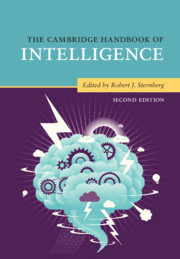Book contents
- The Cambridge Handbook of Intelligence
- The Cambridge Handbook of Intelligence
- Copyright page
- Dedication
- Contents
- Figures
- Tables
- Contributors
- Preface
- Part I Intelligence and Its Measurement
- Part II Development of Intelligence
- Part III Intelligence and Group Differences
- Part IV Biology of Intelligence
- Part V Intelligence and Information Processing
- Part VI Kinds of Intelligence
- 27 The Theory of Multiple Intelligences
- 28 The Augmented Theory of Successful Intelligence
- 29 Emotional Intelligence
- 30 Practical Intelligence
- 31 Social Intelligence
- 32 Collective Intelligence
- 33 Leadership Intelligence
- 34 Cultural Intelligence
- 35 Mating Intelligence
- 36 Consumer and Marketer Intelligence
- Part VII Intelligence and Its Role in Society
- Part VIII Intelligence and Allied Constructs
- Part IX Folk Conceptions of Intelligence
- Part X Conclusion
- Author Index
- Subject Index
- References
28 - The Augmented Theory of Successful Intelligence
from Part VI - Kinds of Intelligence
Published online by Cambridge University Press: 13 December 2019
- The Cambridge Handbook of Intelligence
- The Cambridge Handbook of Intelligence
- Copyright page
- Dedication
- Contents
- Figures
- Tables
- Contributors
- Preface
- Part I Intelligence and Its Measurement
- Part II Development of Intelligence
- Part III Intelligence and Group Differences
- Part IV Biology of Intelligence
- Part V Intelligence and Information Processing
- Part VI Kinds of Intelligence
- 27 The Theory of Multiple Intelligences
- 28 The Augmented Theory of Successful Intelligence
- 29 Emotional Intelligence
- 30 Practical Intelligence
- 31 Social Intelligence
- 32 Collective Intelligence
- 33 Leadership Intelligence
- 34 Cultural Intelligence
- 35 Mating Intelligence
- 36 Consumer and Marketer Intelligence
- Part VII Intelligence and Its Role in Society
- Part VIII Intelligence and Allied Constructs
- Part IX Folk Conceptions of Intelligence
- Part X Conclusion
- Author Index
- Subject Index
- References
Summary
This chapter presents an augmented theory of successful intelligence. Successful intelligence is (1) the ability to formulate, strive for, and, to the extent possible, achieve one’s goals in life, given one’s sociocultural context, (2) by capitalizing on strengths and correcting or compensating for weaknesses (3) in order to adapt to, shape, and select environments (4) through a combination of analytical, creative, and practical abilities. People who are successfully intelligent figure out what life opportunities are available or they can create, and then proceed to optimize on those opportunities. Successfully intelligent people figure out their strengths and weaknesses and then capitalize on the strengths and correct or compensate for their weaknesses.
Keywords
- Type
- Chapter
- Information
- The Cambridge Handbook of Intelligence , pp. 679 - 708Publisher: Cambridge University PressPrint publication year: 2020
References
- 9
- Cited by

